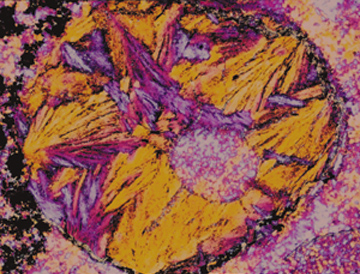
Geotimes Home | AGI Home | Information Services | Geoscience Education | Public Policy | Programs | Publications | Careers

 A giant meteorite
slammed into Earth 3.5 billion years ago — a collision two to five times
larger than the one thought to have wiped out the dinosaurs.
A giant meteorite
slammed into Earth 3.5 billion years ago — a collision two to five times
larger than the one thought to have wiped out the dinosaurs.  As sedimentary
rocks accrete, they incorporate the spherules into impact layers. The Kaapvaal
and Pilbara cratons are the only known formations preserved well enough to retain
clear impact layers from the collision 3.47 billion years ago.
As sedimentary
rocks accrete, they incorporate the spherules into impact layers. The Kaapvaal
and Pilbara cratons are the only known formations preserved well enough to retain
clear impact layers from the collision 3.47 billion years ago. |
Geotimes Home | AGI Home | Information Services | Geoscience Education | Public Policy | Programs | Publications | Careers |